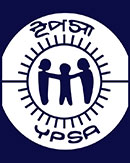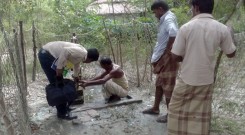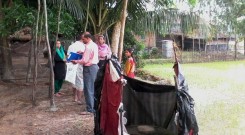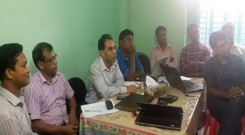Photo Gallery
Background
The monsoon depression over the northeast Bay of Bengal and adjoining Bangladesh coast have intensified into Cyclone Komen on Wednesday, 29 July 2015, causing further downpours in the regions already affected by the previous flash floods and landslides which had started at the end of June 2015. Cyclone Komen made landfall on 30 July, weakening as it moved slightly towards the northeast. Cox’s Bazar, Chittagong, Bandarban, Noakhali, Feni and Bhola districts were significantly affected. At least 4 people were reported dead and a number injured due to the cyclone. Due to the impact of the cyclonic storm “Komen”, heavy rainfall was active all over the country and many areas of the southern Bangladesh were inundated which includes most of the areas affected by the first spell of flooding. The cumulative effect of the floods followed by Cyclone Komen increased the affected population to 2.6 million people.
Project Title : Emergency WASH support to the people affected by South- East flood and cyclone Komen.
Funded By : Margaret A. Cargill Foundation
Technical supported by : PLAN International-Bangladesh
Implemented by: Young Power in Social Action (YPSA)
Project duration : 20 August 2015 to 19 November 2015.
Project Objective :
Prevent epidemic and maintain hygiene standards in the target area through restoration of community WASH (water, sanitation and hygiene) facilities.
Working Area & Beneficiaries Information:
| District | Upazila | Union | Beneficiaries | |
| Cox’s Bazar | Pekua | Barobakia | 500 HH | |
| Mognama | 1000 HH | |||
Target group:
- Highly affected households and displaced households.
- Households with severe damage and loss of homestead/houses, household belongings and livelihoods like standing crops, livestock and/or other livelihood options
- Households with no means to recover the loss on their own and/or with no or little access to income generating activities
- Households that are extremely poor (e.g: with the main income earners who are a day labourer or small/marginal farmers, and/or households that are displaced, landless or unemployed)
- Households with vulnerable people such as pregnant and lactating women, elderly, disabled persons, and chronically ill persons (physically and mentally) or socially excluded people like affected ethnic minority groups. At least 10% of the beneficiaries shall be people with disability.
- Women-headed (separated, divorced, or widowed) households, or child-headed households with no or minimum support or sources of income.
Target of activity:
- Upazila and Union level inception meeting.
- Beneficiary’s selection through community consultation.
- Beneficiaries list endorsement by respective authorities.
- Beneficiary selection through CC and HHs survey
- Project Implementation Committee (PIC) Formation
- Assessment and selection of tube well site as per set criteria
- Repairing of tube well as per set criteria
- Distribution of Jerrican/water container
- Selection and finalization of latrine to be repaired
- Repair of Household Latrines in affected communities
- Distribution of Hygiene kits
- Conduction of hygiene sessions at the community level
- Conduction of hygiene sessions at the school
- Learning sharing workshop




